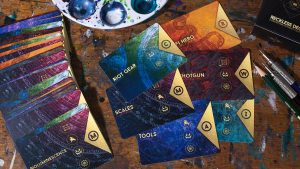Writing Tools: Reckless Deck
 I’ve accumulated a large collection of card-based writing tools, each of which is useful to different parts of my writing process. So I’ve decided to do a series of posts about the various decks I own and how I use them in my writing.
I’ve accumulated a large collection of card-based writing tools, each of which is useful to different parts of my writing process. So I’ve decided to do a series of posts about the various decks I own and how I use them in my writing.
Though it was originally envisioned as an artist prompt deck, Reckless Deck, which I talked about three years ago, also works as a writing tool, particularly if you’re trying to come up with a character to write about.
Reckless Deck uses six categories for creating a character: Intrinsic Nature, Modifications, Weapons, Costumes, Accessories, and Reinvention. Any of the categories can be used independently of the others, you can choose cards only from specific categories, or you can shuffle together all of the cards and just see what you get from it. I find that the Intrinsic Nature and Modifications cards are a good place for me to look to find random superhero (or villain) powers, while Weapons, Costumes, and Accessories add flavor to a nascent character. Reinvention, too, is best paired with other types of cards, as it often just gives you a basic idea of something that exists in the world, but not enough detail to run with that one solo.
The cards are each marked with one or more genre (the genres are Fantasy, Science Fiction, Horror, and Steampunk), and there are also a variety of expansion packs that toss in additional, more specialized genres. The genre markers present an easy way to know if a card might not be a great fit for your purpose–for example, pulling the “A.I. or Hologram” card (marked as Science Fiction only) might not work well if you’re writing a fantasy story. But you can also twist the cards to fit the genre, perhaps turning this one into an illusory being or creature instead. The majority of the cards are applicable to more than a single genre, too, which minimizes the odds that you’ll pull one that’s wholly inappropriate for your genre (and you can always sift through the cards before you shuffle to pull those outliers).
The cards themselves, as pictured above, are fairly simple while still being really pretty. The triangle on the right tells you what type of card it is, but the color and background art also indicates the type of card (though in some cases, you may have to look closely at that). They’re standard playing card sizes, and none of the types have so many cards that they are unwieldy to shuffle individually. (I’d have a hard time if I decided to shuffle all six categories together.)
The biggest downside to this deck is that at the time of this writing, it’s virtually impossible to get your hands on it. My collection is technically Reckless Deck 1 and 2, along with all of the expansions. (I’ll talk more about some specific expansions in future posts.) Because the creator has a recent Kickstarter that’s currently reaching the fulfillment stage, the odds are good that Reckless Deck will be available again soon, so just keep your fingers crossed.
In summary, use Reckless Deck for: new character creation, inspiration for an existing character, superhero powers, and the challenge of how to make a seemingly impossible trait work in a specific genre.

Comments